 “Data-Driven Thinking” is written by members of the media community and contains fresh ideas on the digital revolution in media.
“Data-Driven Thinking” is written by members of the media community and contains fresh ideas on the digital revolution in media.
Today’s column is written by Jay Friedman, chief operating officer at Goodway Group.
It’s generally thought that second-price auctions are better at extracting maximum bids from buyers than first-price auctions.
The auction mechanics of eBay, the world’s largest auction marketplace, are much more closely aligned with second-price auctions than first-price. Second-price auctions typically award the item to the highest bidder, but at the price bid by the second-highest bidder. This encourages buyers to bid their full value, knowing that they are unlikely to pay the full price.
RTB and programmatic had the right idea to pursue a second-price auction from the beginning, but it was executed wrong – publishers suffered and are now exacting their revenge with the help of supply-side platforms (SSPs) using first-price auctions to trump direct-sold bids and each other.
First-price auctions, or English auctions, are the quintessential auction that comes to mind with bidders holding paddles and the winner paying the highest price. You’ll notice the participants looking around the room in typical English auctions, withholding their best bid unless forced to place it.
The digital advertising industry did it wrong originally, but doing it wrong again will not right the original wrong – it will just make it worse. I’d like to propose a plan to come together and make this right for both sides.
Get Educated
How many buyers know we’ve moved to a first-price auction? How many buyers know about the shenanigans played within header bidding, DFP and AdX, to the extent that their bids aren’t even straightforward in the first place? How many buyers and marketers are spending millions of dollars in programmatic yet don’t even have a beginner-level understanding of auction mechanics?
Buyers need to first get educated. “Auctions” is a great book that drills deep enough without getting overly technical. The last chapter is entirely dedicated to online ads.
Then buyers must ask questions of their demand-side platform (DSP), SSPs and publishers. Buyers should know how the auctions work. We’re paid to do this for a living; this is not extra credit.
Focus Solely On Win-Win Behavior
For nearly 10 years the buy side bought programmatically at a gigantic advantage. Thousands of bids competed but were ultimately narrowed down to five to 10 through DSP aggregation before being passed to the SSP holding the auction.
The two highest bids overall may have been $11 and $10, but if both bids came from the same DSP and the highest bid from any other DSP was $5, the winner paid $5.01, courtesy of the second-price bid. This hurt publishers. Now, however, SSPs most often take that $11 bid and let it sail through into DFP at $11. This is terrible for buyers.
These are both win/lose scenarios, but there is a win/win scenario. We all must get over our desire to win “even more” at someone else’s expense and focus on ways to win together.
Both Sides Must Share More Data
DSPs should pass the two highest bids at all times. Yes, this takes re-engineering and will cost more. The total savings to the buy side will be well worth it in the end because this guarantees every publisher and SSP will see the two highest bids regardless of where they originate.
In kind, SSPs should create lost bid data feeds available for DSPs that show the winning bid and the bid density for each lost bid. These feeds should be free to DSPs that spend over a certain, fair threshold. DSPs and buyers will then have a better ability to value inventory against the likelihood of generating a conversion ahead of time and make more appropriate bids.
Here’s something both sides seem to be forgetting. Our fight is not against each other – the buy vs. sell sides – it’s against the tens of billions of dollars that are not yet spent programmatically. Fighting each other only delays the transitioning of additional money into programmatic and the more profitable future this brings to both sides.
Follow Jay Friedman (@jaymfriedman) and AdExchanger (@adexchanger) on Twitter.
This post was syndicated from Ad Exchanger.

More Stories
PEDIGREE® helps pet parents spot the porkies with new Lie Detector
Revolving Door Round-Up: Antonia Hylton and Elise Jordan to Co-Host The Weekend
Kiwi Mobile’s latest campaign walks the talk